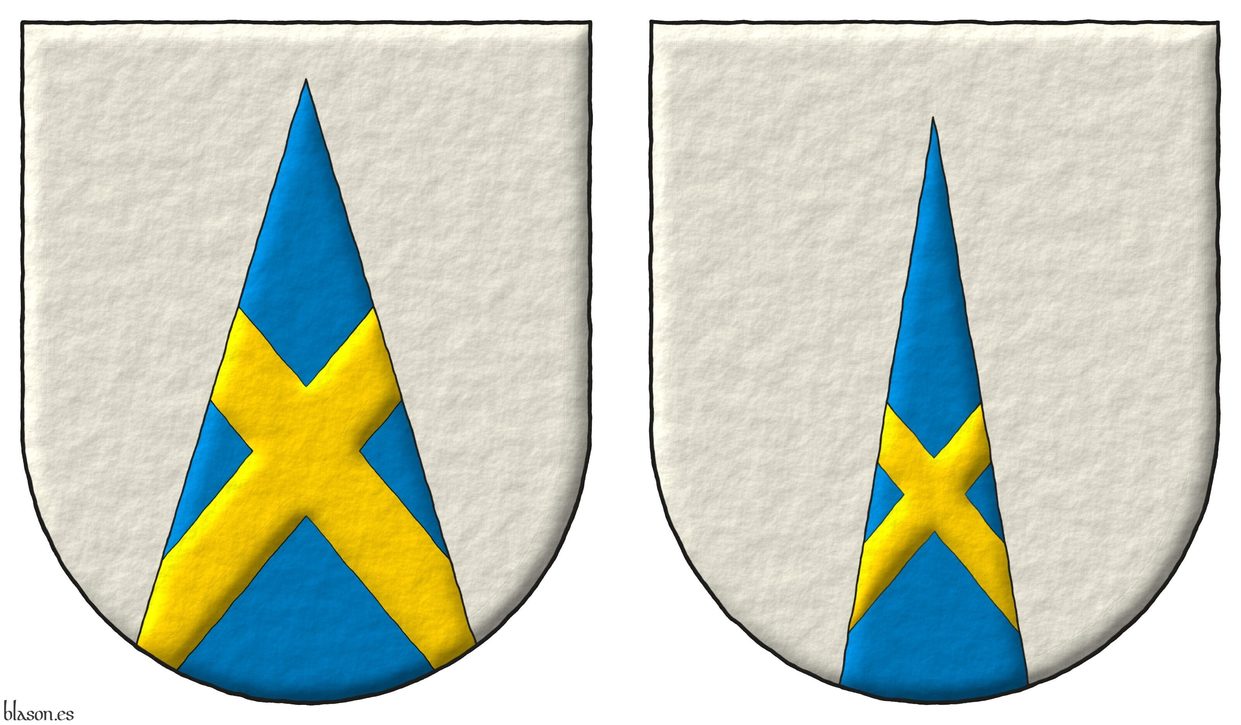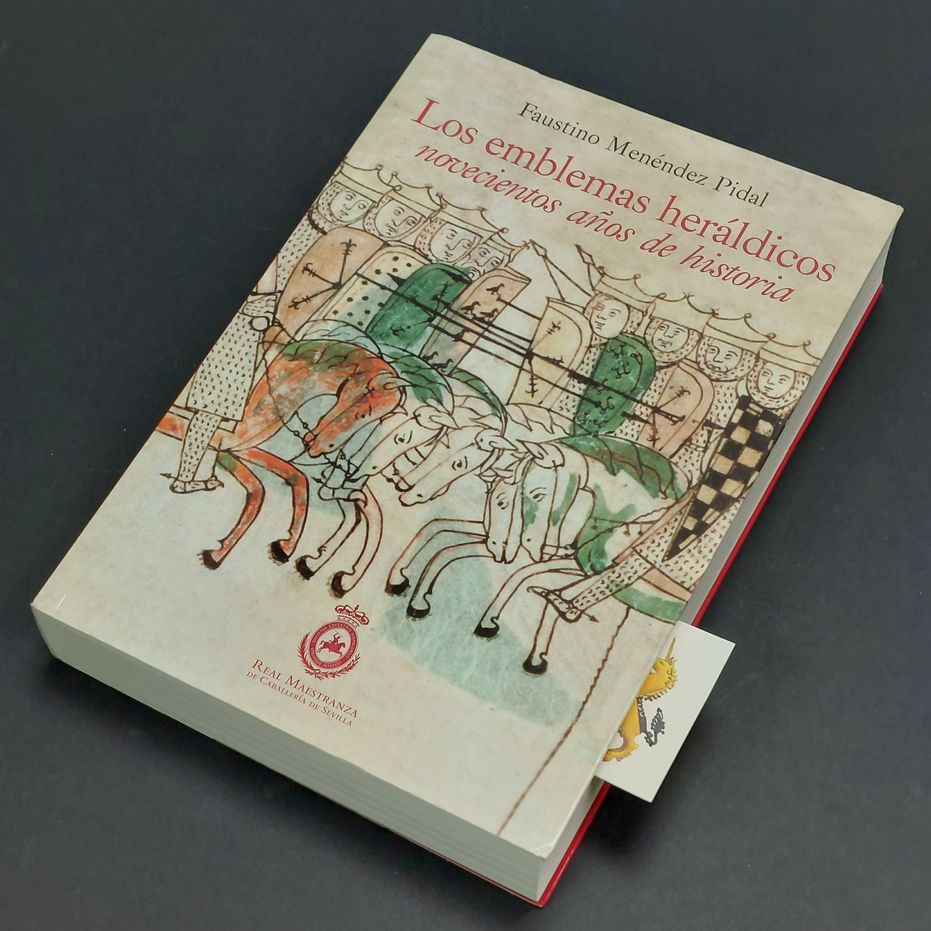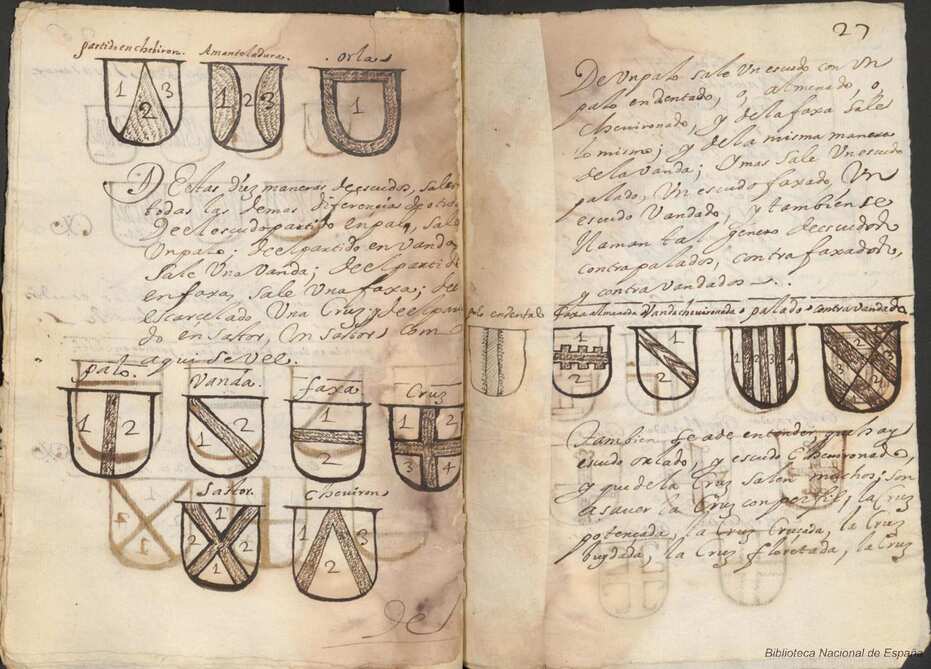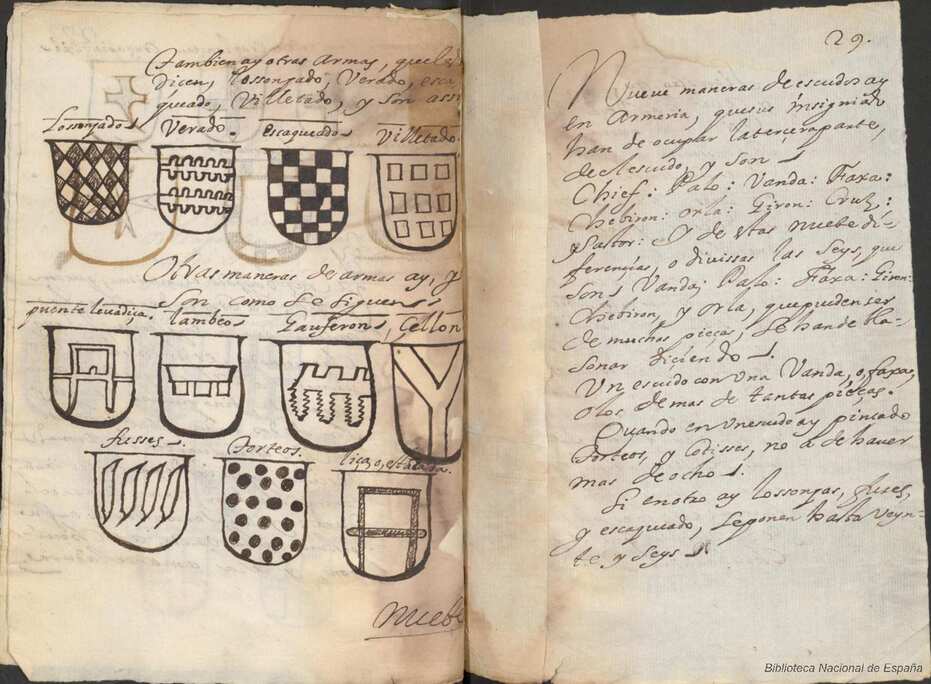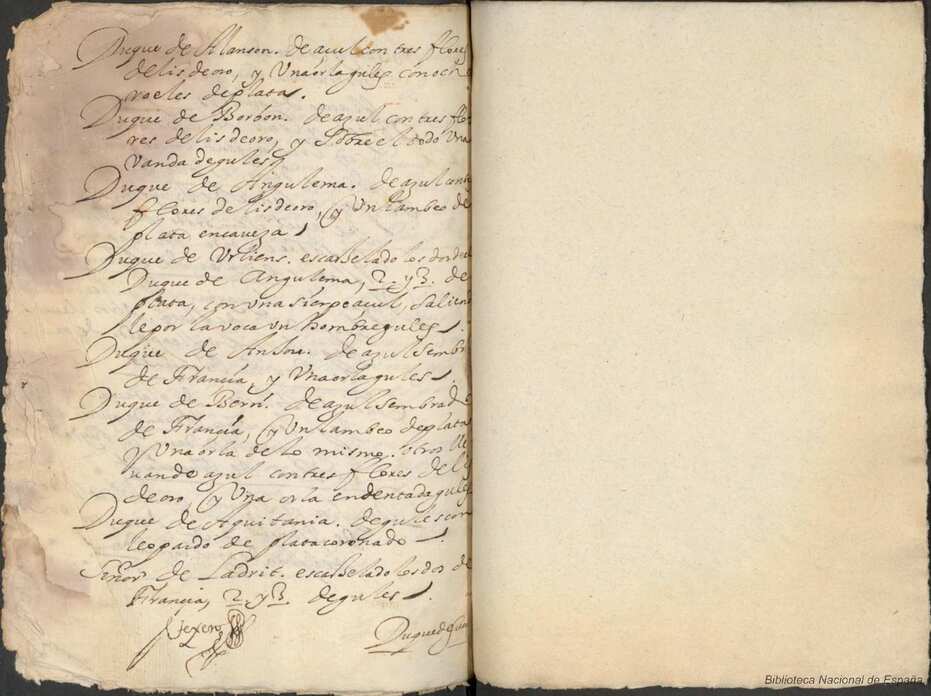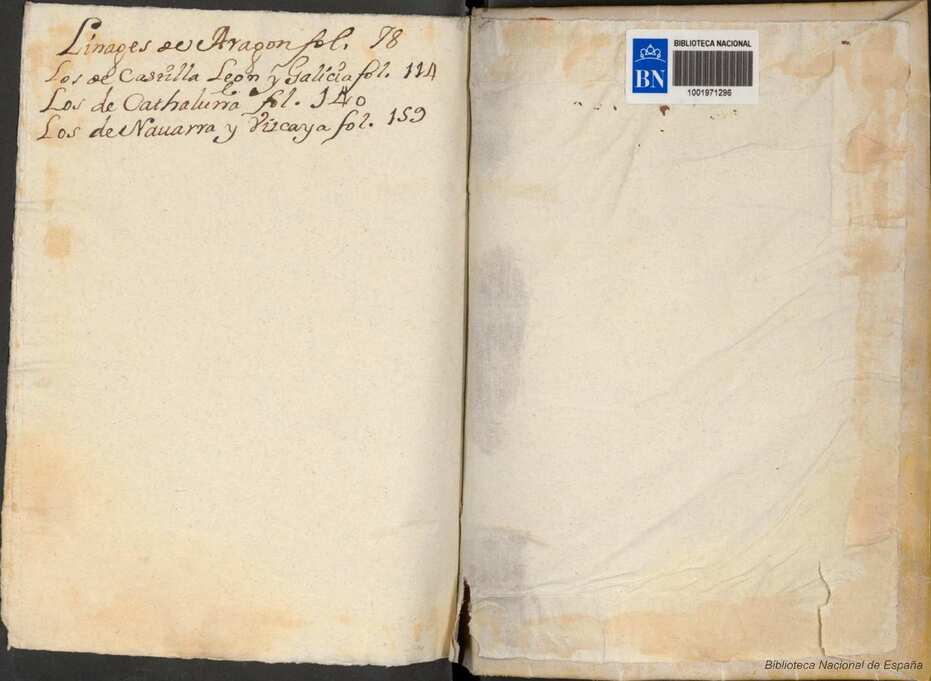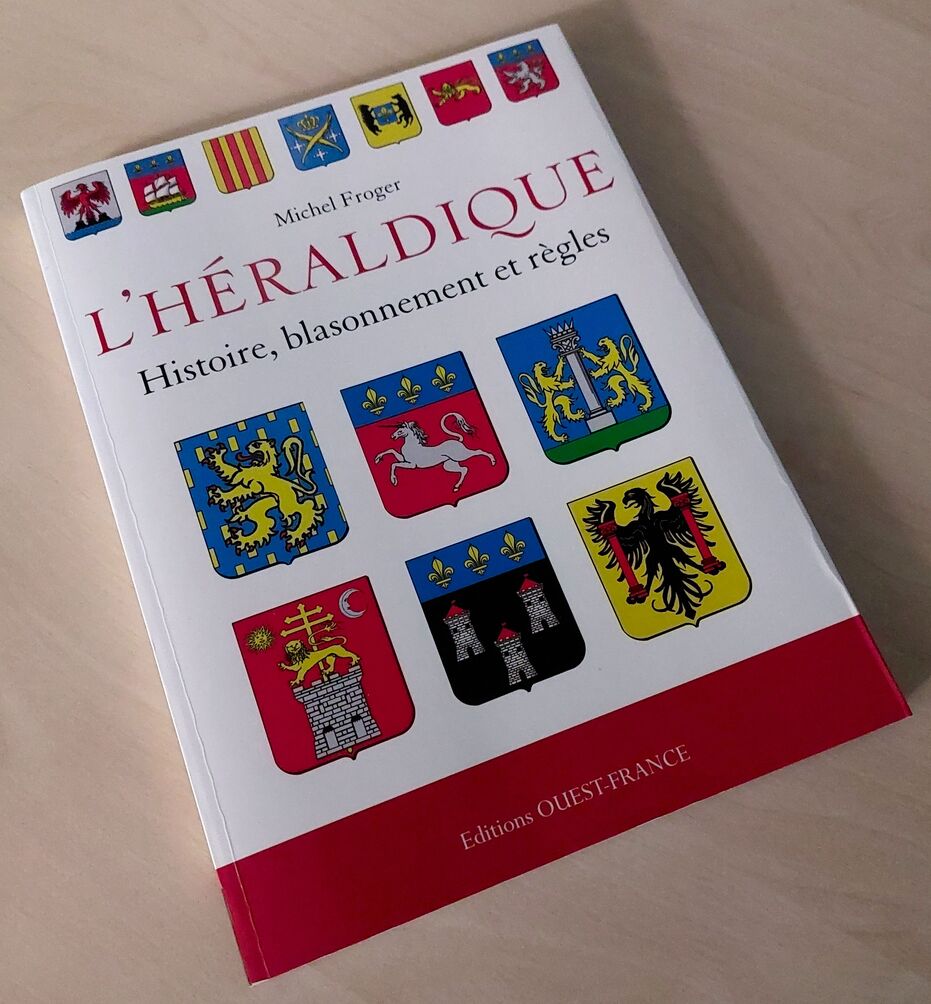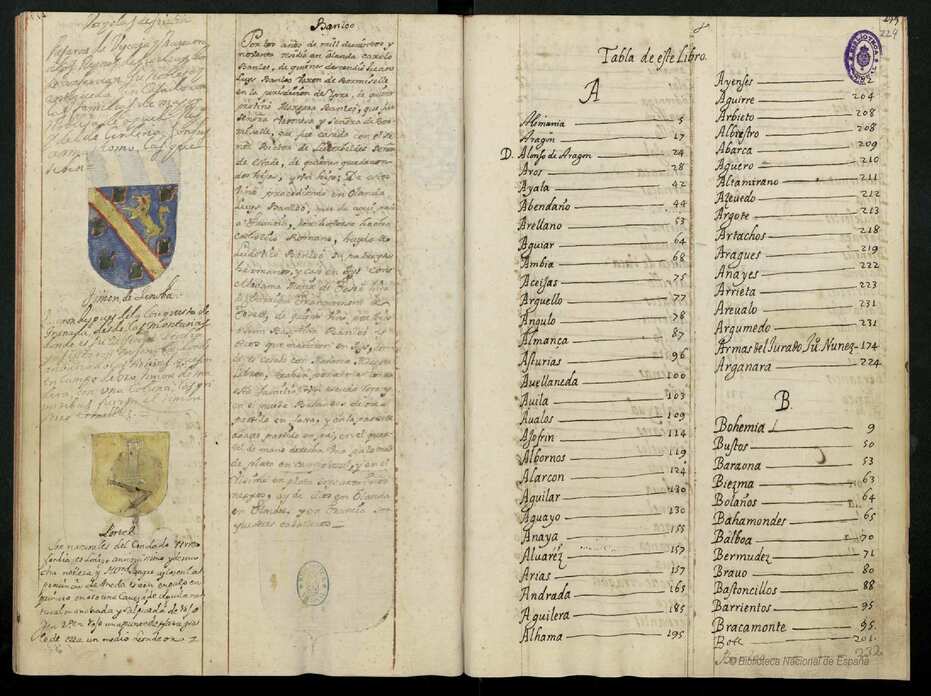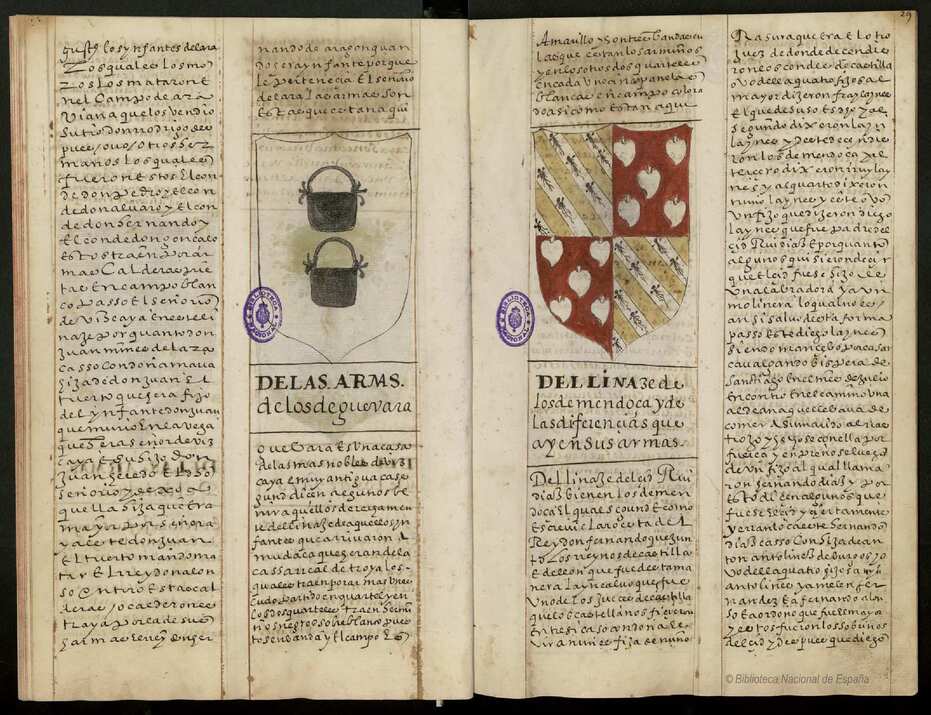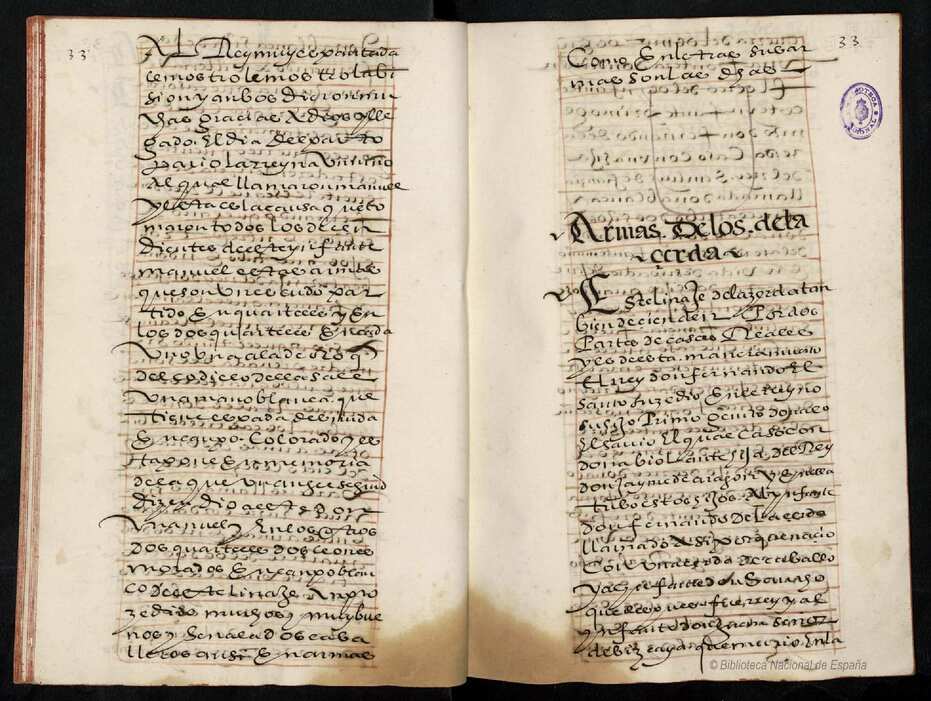
Rage from Discord
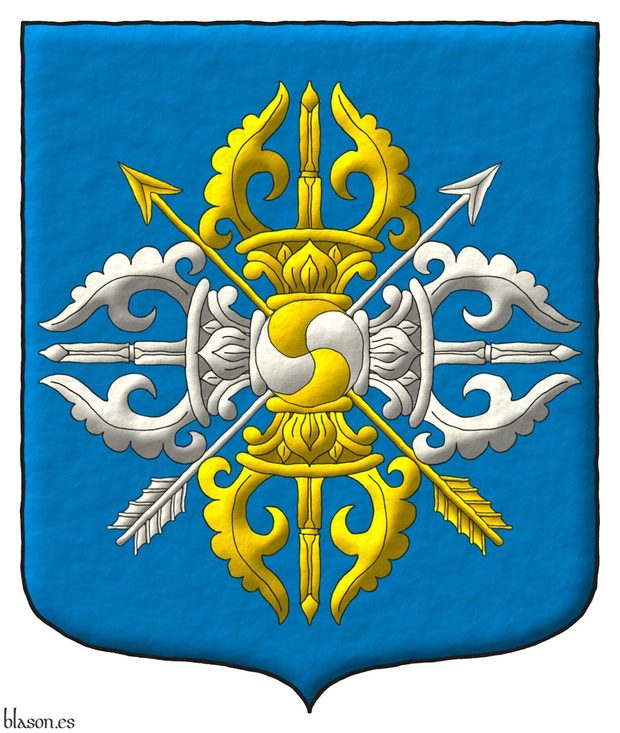
Azure, two arrows in saltire points upward, the arrow bendwise Or, the arrow bend sinisterwise Argent, overall a double vajra per saltire Or and Argent charged with a bezant per saltire curved Or and Argent.
Escudo de azur, dos flechas alzadas en sotuer, la flecha puesta en banda de oro, la flecha puesta en barra de plata, brochante sobre el todo una vajra doble cuartelada en sotuer de oro y plata cargada de un bezante cuartelado en sotuer curvilíneo de oro y plata.
Coat of arms interpreted and emblazoned by me with different shapes and a freehand finishing.
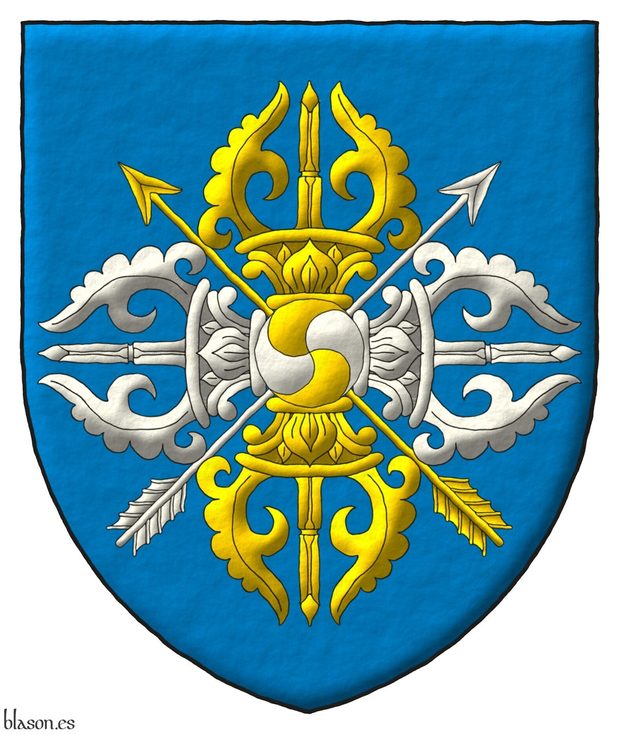
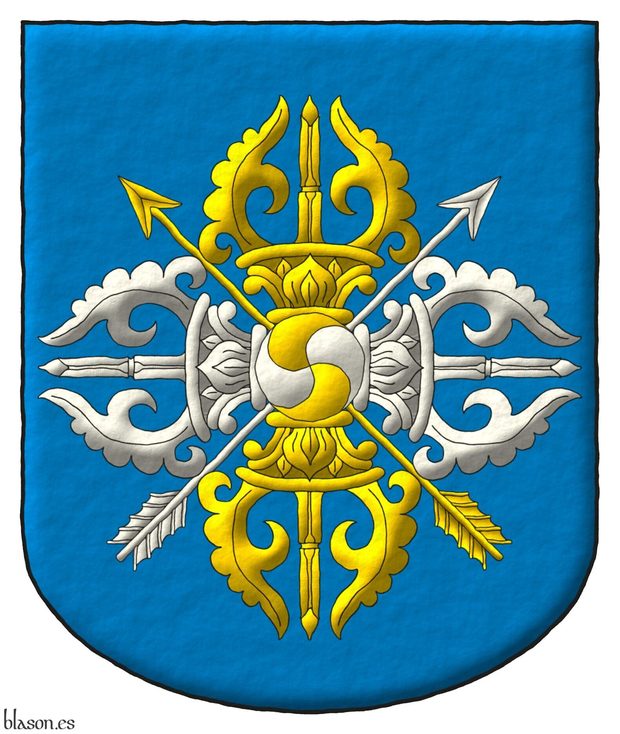
Blazon keywords: Azure, Two, Arrow, Point upwards, In saltire, Bendwise, Or, Bend sinisterwise, Argent, Overall, One, Double vajra, Quarterly per saltire, Charged, Bezant and plate and Curved.
Style keywords: Outlined in sable, Illuminated, Freehand, Rounded, Ogee and Pointed.
Classification: Interpreted and Coat of arms.
Bearer: Rage from Discord.


Vilardi, lineage of Italy
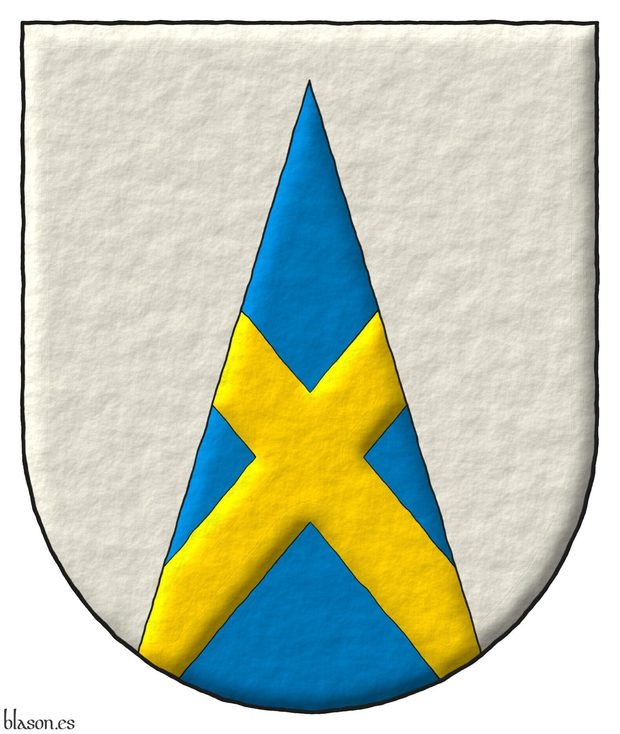
Blazon of the Vilardi lineage of Italy.
Argent, on a pile issuant from the base Azure a saltire Or.
Escudo de plata, una pira de azur cargada de un sotuer de oro.
Illuminated and a free hand finishing.
[Cadenas y Vicent, V. de; 2002; page 138] says that the a pile issuant from the base is «a triangle whose base issues from the base of the shield, being a third of its width», but when it is painted in [Cadenas y Vicent, V. de; 2002; page 268, figure 279] along with the pile the width of the base of both isosceles triangles is 2/3 of the width of the shield. I think the width of 2/3 is, in these 2 cases, better than 1/3 width, because with 1/3 there is not enough room for charges, as shown in the figure below.
There are scholars who say that the pile issuant from the base must not touch the upper edge of the shield and others that its tip should be in the center of the chief. In the previous image, the pile issuant from the base of the 1st shield fulfills the first affirmation, and in the 2nd shield, its tip is in the center of the chief.
I have the doubt if it should not be a saltire raguly.
Blazon keywords: Without divisions, Argent, One, Pile issuant from base, Azure, Charged, Saltire and Or.
Style keywords: Freehand, Outlined in sable, Illuminated and Semi-circular.
Classification: Interpreted, Lineage and Italian Republic.


Val'Quirico, freehand
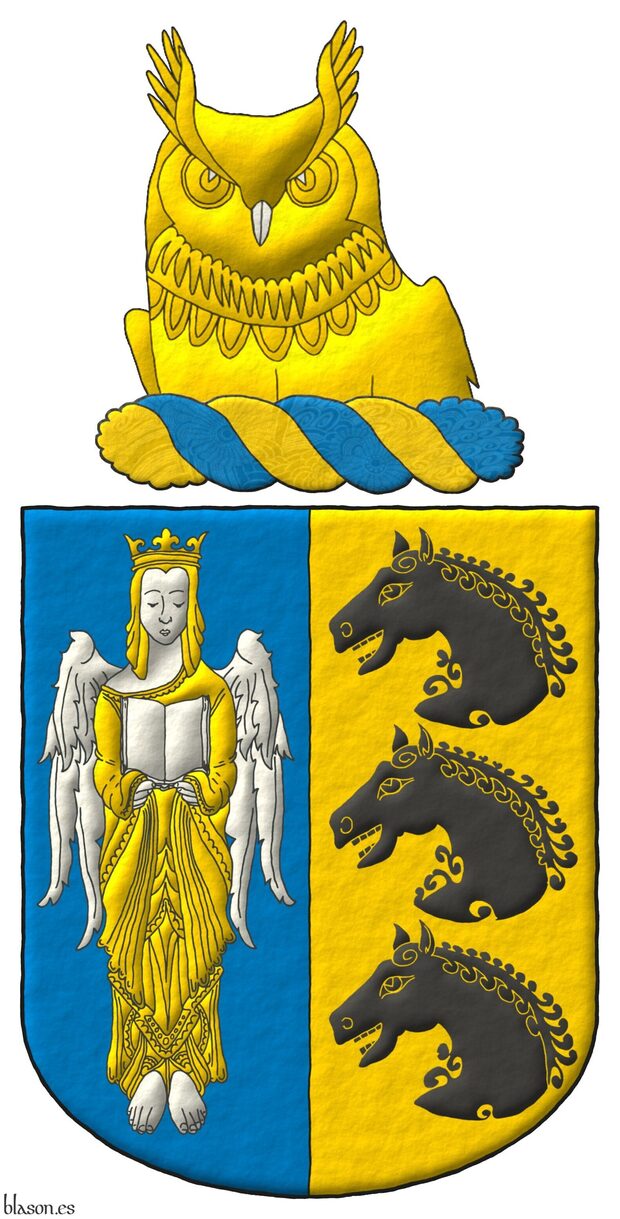
Party per pale: 1 Azure, an angel Argent, crowned, crined and vested Or holding an open book Argent; 2 Or, three horses' heads couped, in pale Sable. Crest: Upon a wreath Or and Azur, an owl's head couped at the shoulders Or, beaked Argent.
Escudo partido: 1o de azur, un ángel de plata, coronado, cabellado y vestido de oro cargado con un libro de plata abierto; 2o de oro, tres cabezas de caballo cortadas, en palo de sable. Timbrado de un burelete de oro y azur cimado de un búho naciente de oro, picado de plata.
Freehand finish.
Blazon keywords: Party per pale, Azure, One, Angel, Argent, Crowned, Crown, Crined, Vested, Or, Charged, Book, Open, Three, Head, Horse, Sable, Couped, In pale, Crest and mantling, Wreath, Owl, Nascent and Beaked.
Style keywords: Watercolor, Illuminated, Rounded, Outlined in the field tincture and Outlined in sable.
Classification: Created and Socioeconomic.
Bearer: Club Ecuestre Val'Quirico.


![Ver [Menéndez Pidal de Navascués, F.; 2014a] en referencias bibliográficas. Libro abierto, hojas de plata, filo de oro, guardas de gules, tapas de sable.](../css/Libro.Bibliografia.png)
Menéndez Pidal de Navascués, F.; 2014a
Faustino Menéndez Pidal de Navascués, «Los emblemas heráldicos: novecientos años de historia», Royal Cavalry Armory of Seville, Culture and Nobility Collection, 508 pages, ISBN.13 9788494139208, Seville, 2014.
Bibliographical reference of century XXI.
Classification: In color and Castilian language.
The author is Menéndez Pidal de Navascués, Faustino.
Internal resources: Physical book.


![Ver [Tejero de Rojas y Sandoval, J. F.; XVII] en referencias bibliográficas. Libro abierto, hojas de plata, filo de oro, guardas de gules, tapas de sable.](../css/Libro.Bibliografia.png)
Tejero de Rojas y Sandoval, J. F.; XVII
Juan Francisco Tejero de Rojas y Sandoval, «Linajes de Aragón, Castilla, León, Galicia, Cataluña, Navarra y Vizcaya», 198 hand-numbered pages, each 2, in Arabic numerals, with numerous blank pages not numbered at the beginning and end, hand index on the back of the last page before the back cover, 22 x 17 centimeters, illustrations in the pages 26-29, in the National Library of Spain, signatures Mss/12617, it is estimated from the XVII century.
Unfinished
Although the last page 198 is signed on the back, the book seems unfinished because at the end of the last page there is a last line with a few loose words «Duke of...» which are a sign that it continues on the next page, but the next page is blank.
Bibliographical reference of century XVII.
Classification: Manuscript, In black and white and Castilian language.
The author is Tejero de Rojas y Sandoval, Juan Francisco.
External links:
- Detail of this manuscript in the National Library of Spain.
- Bibliographic record of the National Library of Spain.
- Scanned manuscript in the National Library of Spain.
Internal resources: TejeroRojasSandovalJFXVII.Pagina.11.Linajes.pdf.
Credits: This book belongs to the Biblioteca Nacional de España. License Creative Commons CC-BY. You may share, transform and create from images in the public domain that are accessible in the Hispanic Digital Library.


![Ver [Froger, M.; 2012] en referencias bibliográficas. Libro abierto, hojas de plata, filo de oro, guardas de gules, tapas de sable.](../css/Libro.Bibliografia.png)
Froger, M.; 2012
Michel Froger, «L'héraldique: histoire, blasonnement et règles», 127 pages, more than 1000 color illustrations, Editions Ouest-France, ISBN.13 9782737357923, Rennes, 12 September 2012.
Bibliographical reference of century XXI.
Classification: In color and French language.
Author: Froger, Michel.
Internal resources: Paper edition, gifted by the author.


![Ver [Pérez de Vargas, J.; XVI] en referencias bibliográficas. Libro abierto, hojas de plata, filo de oro, guardas de gules, tapas de sable.](../css/Libro.Bibliografia.png)
Pérez de Vargas, J.; XVI
Juan Pérez de Vargas, «Nobiliario», 228 pages with 2 columns, index between pages 224 and 228 ordered by initial but unordered within each initial, 31 x 23 centímeters, kept in the National Library of Spain, signature Mss/3061, it is estimated from the XVI century.
Structure
It follows a fixed structure for each entry: the name of the lineage or person, a horizontal line of separation, a explanatory text, a horizontal line of separation, coat of arms with the with of the column and full-color, a horizontal final line. All of this within the columns, only coming out for some exterior decorations, which I especially like.
My collaboration with the National Library of Spain
I have collaborated with the Department of Manuscripts, Incunabula, and Rare Books of the National Library of Spain to correctly attribute the authorship of this 16th century manuscript armorial titled «Nobiliario», signature Mss/3061, to Juan Pérez de Vargas. It has been quite an honor.
Bibliographical reference of century XVI.
Classification: Manuscript, Armorial roll, In color and Castilian language.
Author: Pérez de Vargas, Juan.
External resources:
- Detail of this armorial in the National Library of Spain.
- Bibliographic record of the National Library of Spain.
- Scanned Armorial in the National Library of Spain.
Internal resources: Pages from 1 to 117 PerezDeVargasJXVI.11.Paginas.001.117.pdf and Pages from 118 to 235 PerezDeVargasJXVI.12.Paginas.118.235.pdf.
Credits: This book belongs to the Biblioteca Nacional de España. License Creative Commons CC-BY. You may share, transform and create from images in the public domain that are accessible in the Hispanic Digital Library.


![Ver [Rodríguez de la Vega, A.; XVI] en referencias bibliográficas. Libro abierto, hojas de plata, filo de oro, guardas de gules, tapas de sable.](../css/Libro.Bibliografia.png)
Rodríguez de la Vega, A.; XVI
Alonso Rodríguez de la Vega, «Roll of arms of Spain», 377 hand-numbered pages in Arabic numerals, all coat of arms illustrations are only partially outlined and without tinctures, written according to the title page in the time of Emperor Charles V, in the National Library of Spain, signatures Mss/3330, it is estimated from the XVI century.
Bibliographical reference of century XVI.
Classification: Manuscript, Armorial roll, In black and white and Castilian language.
Author: Rodríguez de la Vega, Alonso.
External resources:
- Detail of this armorial in the National Library of Spain.
- Bibliographic record of the National Library of Spain.
- Scanned Armorial in the National Library of Spain.
Internal resources: RodriguezDeLaVegaAXVI.11.Paginas.001.129, RodriguezDeLaVegaAXVI.12.Paginas.130.258.pdf and RodriguezDeLaVegaAXVI.13.Paginas.259.387.pdf.
Credits: This book belongs to the Biblioteca Nacional de España. License Creative Commons CC-BY. You may share, transform and create from images in the public domain that are accessible in the Hispanic Digital Library.

Continue with: Avilés, T. de; XVI.
-
Language
-
Categories of heraldry
-
Divisions of the field
- Without divisions
- Party per pale
- Party per fess
- Party per bend
- Party per bend sinister
- Tierce
- Tierce sinister
- Tierced per pale
- Tierced per fess
- Tierced per bend
- Tierced pallwise inverted
- Quarterly
- Quarterly per saltire
- Gyronny
- Party per fess, the chief per pale
- Party per pale, the sinister per fess
- Party per fess, the base per pale
- Party per pale, the dexter per fess
- Chapé
- Chaussé
- Embrassé
- Contre-embrassé
- Party per chevron
- Enté
- Enté en point
- Flanched
-
Metals
-
Colours
-
Furs
-
Other tinctures
-
Ordinaries and sub-ordinaries
-
Diminutives of the ordinaries
-
Geometric charges
-
Composite ordinaries
-
Inanimate charges from Nature
Atom, Crescent, Diamond, Emerald, Estoile, Increscent, Lightning flash, Moon, Mount, Mullet, Mullet of four points, Orbital, Plough of Ursa Major, Rainbow, Ray of the sun, River, Sea, Snowflake, Sun, Sun in splendour, Sun of May, Trimount, Water and Wave.
-
Vegetal charges from Nature
Acorn, Apple, Apple tree, Ash, Bluebonnet, Camellia, Chrysanthemum, Cinquefoil, Cornflower, Dogwood flower, Double rose, Elm, Fleur de lis, Flower, Gourd, Holm oak, Hop cone, Kapok tree, Laurel, Lily, Linden, Lotus flower, Madonna lily, Mexican cedar tree, Oak, Olive tree, Palm tree, Plantain plant, Pomegranate, Poplar leaf, Rose, Shamrock, Sunflower, Thistle, Tree, Tulip, Vine and Wheat.
-
Animal charges from Nature
Badger, Bald eagle, Barbel, Barn owl, Bear, Beaver, Beetle, Bighorn sheep, Blackbird, Boar, Brach hound, Bull, Doe, Dog, Dolphin, Dove, Eagle, Elephant, Falcon, Female figure, Fish, Flame, Fly, Fox, Frog, Goat, Goldfinch, Goose, Heron, Horse, Hummingbird, Jaguar, Lark, Leopard, Lion, Lion passant, Lion rampant guardant, Lioness, Lynx, Male figure, Martlet, Merino ram, Owl, Panther, Parrot, Peacock, Pelican, Pelican in her piety, Puffin, Quetzal, Raven, Roe deer, Rooster, Savage, Seagull, Serpent, She-wolf, Stag, Starling, Talbot, Tyger, Vulture, Warren hound and Wolf.
-
Parts of natural charges
Arm, Beak, Branch, Caboshed, Chest, Claw, Covert, Dorsal fin, Eagle claw, Ermine spot, Escallop, Feather, Foot (palmiped), Foreleg, Forepaw, Hand, Head, Heart, Hoof, Leaf, Neck, Ostrich feather, Palm frond, Paw, Roe deers' attires, Shoulder, Sprig, Stags' attires, Stem, Swallow-tail, Tail, Tail addorsed, Tail fin, Talon, Tooth, Trunk, Trunk (elephant), Two hands clasped, Two wings in vol, Udder, Wheat spike, Wing and Wrist.
-
Artificial charges
Ace of spades, Anchor, Anvil, Arch, Arm vambraced, Armillary sphere, Arrow, Axe, Bell, Bell tower, Beret, Bonfire, Book, Bookmark, Bow, Branding iron, Bridge, Broken, Buckle, Cannon, Cannon dismounted, Cannon port, Canopy roof, Carbuncle, Castle, Celtic Trinity knot, Chain, Chess rooks, Church, Clarion, Clay pot, Closed book, Club, Column, Comb, Compass rose, Conductor's baton, Cord, Covered cup, Crozier, Crucible, Cuffed, Cup, Cyclamor, Dagger, Double vajra, Drum, Ecclesiastical cap, Fanon, Federschwert, Fleam, Four crescents joined millsailwise, Galician granary, Garb, Gauntlet, Geometric solid, Grenade, Halberd, Hammer, Harp, Host, Hourglass, Key, Key ward, Knight, Knot, Lantern, Letter, Line, Loincloth, Menorah, Millrind, Millstone, Millwheel, Monstrance, Mortar, Mullet of six points pierced, Nail, Non-classic artifact, Norman ship, Number, Oar, Oil lamp, Open book, Page, Pair of scales, Parchment, Pestle, Piano, Pilgrim's staff, Plough share, Polish winged hussar, Port, Portcullis, Potent, Quill, Ribbon, Rosette of acanthus leaves, Sabre, Sackbut, Sail, Scroll, Scythe, Sheaf of tobacco, Ship, Skirt, Spear, Spear's head, Stairway, Star of David, Step, Sword, Symbol, Tetrahedron, Torch, Tower, Trident, Trumpet, Turret, Two-handed sword, Wagon-wheel, Water-bouget, Wheel, Winnowing fan and With a turret.
-
Immaterial charges
Angel, Archangel, Basilisk, Dragon, Dragon's head, Garuda, Golden fleece, Griffin, Heart enflamed, Justice, Mermaid, Our Lady of Mercy, Ouroboros, Paschal lamb, Pegasus, Phoenix, Sacred Heart of Jesus, Saint George, Sea-griffin, Trinity, Triton, Unicorn, Winged hand and Wyvern.
-
External elements
-
Heraldic creations
-
References
-
Formats
-
Keywords on this page
Open, Watercolor, Point upwards, Pointed, Armorial roll, Azure, Bezant and plate, Bibliography, Overall, Wreath, Owl, Horse, Crined, Head, Charged, Club Ecuestre Val'Quirico, Ogee, Crown, Crowned, Couped, Created, Quarterly per saltire, Curved, Outlined in sable, Outlined in the field tincture, Two, In black and white, In color, In pale, In saltire, Coat of arms, Arrow, Illuminated, Interpreted, Castilian language, French language, Book, Lineage, Manuscript, Semi-circular, Nascent, Or, Party per pale, Argent, Rounded, Century XVI, Century XXI, Freehand and One.

